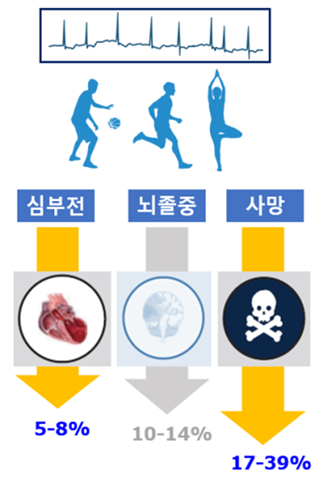Exercise reduces the risk of heart failure and death in patients with atrial fibrillation
When patients engage in exercise after being diagnosed with atrial fibrillation, stroke 14%↓, heart failure 8%↓, death 39%↓
Initiating or continuing regular exercise after atrial fibrillation diagnosis was associated with a reduced risk of heart failure and death. Exercise is expected to reduce the risk of side effects that may occur in the future in patients with atrial fibrillation.
 heart failure, stroke, death
heart failure, stroke, death
Using the data from the National Health Insurance Corporation, Seoul National University Hospital Professor Choi Eue-Keun’s team (Prof Lee Soryoung, Dr Ahn Hyo-Jung) and Soongsil University Professor Han Kyung-do’s team published the results of a study of the association of exercise habits and risk of stroke, heart failure, and death in patients with atrial fibrillation.
Atrial fibrillation is one of the most common cardiac arrhythmias. It is a disease with high prevalence, accounting for about 10% of diseases in the elderly. To improve the prognosis, there are various treatments that can be done such as anticoagulant therapy, antiarrhythmic drugs, and atrial fibrillation electrode catheter ablation.
Atrial fibrillation patients are 5 to 7 times more likely to have a stroke, 2 times more likely to experience heart failure, and have a 1.5 to 3.5 times higher than normal chance of death. Therefore, at the same time as diagnosis, active treatment and lifestyle modification are essential to prevent these complications of cardiovascular disease
In the meantime, there have been many studies examining the relationship between exercise and atrial fibrillation-related symptoms, along with their recurrence, and reduction of their burden in patients with atrial fibrillation. However, information on cardiovascular outcomes related to exercise habit changes after atrial fibrillation diagnosis was lacking.
The researchers investigated the association between changes in exercise habits after atrial fibrillation diagnosis and stroke, heart failure, and death.
The research team studied 66,692 patients with newly diagnosed atrial fibrillation between 2010 and 2016, according to changes in their regular exercise habits; ▲Continuous non-exercisers (30.5%) ▲New exercisers (17.8%) ▲People who had stopped exercising (17.4%) and ▲ Exercise maintainers (34.2%) were divided into 4 groups and compared. Their rates of stroke, heart failure and death were followed for approximately four years.
As a result, the risk of heart failure was observed to be respectively 5% and 8% lower in the new exercise group and the exercise maintainer group than in the persistent non-exercise group.
In addition, exercise at any time before or after atrial fibrillation diagnosis was associated with a 17-39% lower risk of death compared to not exercising continuously. Of the sample group, 17% had stopped exercising, 18% had started exercising, and 39% had continued to exercise. In the case of stroke, it was confirmed that there was a tendency to decrease its risk by 10 to 14% in the exercise group.
In particular, the research team revealed for the first time the type and intensity of exercise that is optimal for patients with atrial fibrillation. Moderate-intensity exercises, such as brisk walking, biking at a normal speed, and cloth-cleaning floors on all fours, for 170 to 240 minutes a week, and high-intensity exercises such as running, aerobics, and mountain climbing for 140 to 210 minutes a week were found to have the greatest association with a reduction in the risk of cardiovascular disease and death.
The researchers emphasized that this is the first study to examine the association between exercise and important clinical outcomes, such as cardiovascular disease and death, in patients with atrial fibrillation.
Professor Eui-Geun Choi (Department of Cardiology) explained the results of the research, saying, "We found that lifestyle modifications such as exercise are associated with a reduction in the risk of heart failure or death in patients diagnosed with atrial fibrillation, and may also potentially be associated with a reduction in the risk of stroke."
In addition, he mentioned that “Based on these results, we can say with certainty that exercise that can increase heart rate is not harmful to patients newly diagnosed with atrial fibrillation in the clinic.” He also emphasized, "This study is significant in that it has provided a scientific basis for encouraging patients to start or continue exercising."
Professor Han Kyung-Do (Department of Information Statistics and Actuarial Sciences) said, “This study’s design utilized the advantages of access to data from the Health Insurance Corporation,” and added, “We will continue to use these data in a variety of ways to provide practical and high-quality evidence that is helpful for treatment.”
This study was published in 'PLOS Medicine (IF 11.069)', a renowned international academic journal in the field of medicine.

[Picture] From Left, Department of Cardiology Prof Choi Eue-Keun, Prof Lee Soryoung, Dr Ahn Hyo-Jung, and Prof Han Kyung-Do of Soongsil University